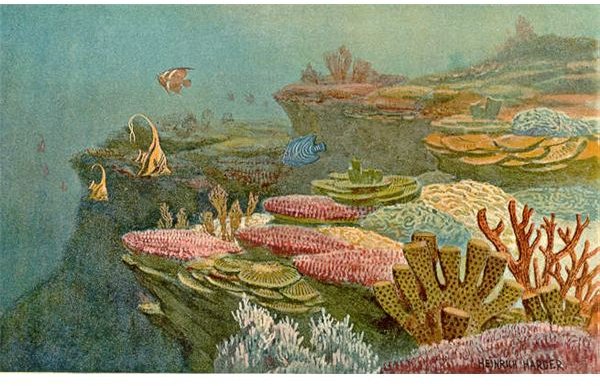Marine Biomes: Important Facts on the Tropical Ocean
Tropical Waters
Tropical ocean biomes are some of the most delicate of all marine biomes. Important facts about coral reefs and the delicate life that exists in and around them demonstrate the immediate need for conservation and protection. Each day the life within the tropical waters that surround the Earth falls prey to pollution, climate change and ignorance. Instructing and informing others of the precarious balance of these biomes helps to save them.
The Coral Reef
Coral consists of colonies of small marine creatures called coral polyps. There are two distinct forms of coral - hard coral and soft coral.
Symbiotic algae create the exoskeleton of hard coral, forming coral reefs, which provide food, shelter and protection of other marine life. Soft coral, resembling sea plants, lives in both the tropical seas and cooler ocean waters. Both forms are on the endangered list.
Coral is a carnivore, catching microscopic zooplankton in the tentacles that surround its mouth. While zooplankton are food for the coral
polyps, the coral reef itself is home to hundreds of fish, sea creatures and plants, each relying on the other for shelter, food and companionship.
Climate change, pollution and the fishing industry endanger the coral reefs of the world.
Tropical Reptiles
Coral reefs are not the only endangered creatures in the tropics. Many of the other sea creatures struggle for survival, also. Tropical reptiles around the globe are either endangered or threatened.
The reptiles that live in the tropical oceans of the world include turtles, crocodilians, sea snakes and marine iguanas.
Sea turtles are a diverse group. People once hunted sea turtles for their shells, meat and eggs. Sea turtles lay their eggs in the warm sands of tropical beaches. Due to the punctuality of the gestation period, it is easy for poachers to calculate when the baby turtles will hatch. In addition to poachers, sea turtles eggs and hatchlings are prey for sea birds, dogs and raccoons. Adult sea turtles live to be close to 50 years old. Their only predator, besides humans, is the shark.
Much of the habitat of crocodilians (crocodiles, caimans and alligators) in the tropics of North America is gone. Prehistoric looking, crocodiles and alligators live in the shallow waters along the coast. Feared by humans, many people do not think that crocodilians have predators. Actually, these reptiles are prey to large cats, such as jaguars and cougars as well as pythons and anaconda. Hatchlings become tasty treats for eagles, herons and other carnivorous water birds.
True sea snakes, hydrophiids, live in Australia. The venom of sea snakes is more lethal than land snakes, but their fangs are small and do not penetrate a wetsuit. In addition, they don’t often bite people, unless they bothered. Other sea snakes, such as the blue and black banded sea snake swim along the shores of the southern Pacific.
Galapagos marine iguanas are herbivores with dwindling numbers due rats and dogs introduced by humans to the islands.
Mammals and Fish
Many sea mammals live in the warm waters of the tropical zone. Some live in the tropics year-round, others, like whales, porpoises and dolphins return each year to mate and give birth in the warm waters. In addition, thousands of colorful fish, such as angel, parrot and clown fish live in and around coral reefs. Sharks, manta rays and eels also lurk in the warm waters.
One of the most interesting and gentlest sea mammals is the manatee. Manatees, also called dugong or Steller’s sea cow, live in the shallow waters along the coast as well as canals. In recent years, restrictions along the canals and rivers of the southern states brought attention to the plight of the manatees. Powerboats are greatest cause of death for manatees and their calves.
Plant Life
Plant life in tropical oceans runs from microscopic plankton to huge beds of seaweed. While huge whales and tiny coral polyps feed on plankton, some varieties of tropical seaweed are a food enjoyed by humans. In addition, chemists use seaweed as a component in beauty products, whereas research look for medical cures. Climate changes endanger some varieties of seaweed and plankton that depend on the warm waters of the tropics to survive.
Under the Sea
Other life forms, such as crustaceans, bi-valves, and sea cucumbers, also call the tropical ocean biomes home. For this reason, it is imperative that we understand the delicate balance of all marine biomes. Important facts, such as what is causing endangerment and how to protect the various species must be available to everyone.
References:
- Missouri Botanical Gardens: Tropical Oceans, 2002 - https://www.mbgnet.net/salt/coral/index.htm
- Coral Reef Alliance: Coral Reef Overview, 2010 - https://www.coral.org/resources/about_coral_reefs/coral_overview
- Save the Manatee: Manatee Facts - https://www.savethemanatee.org/manfcts.htm
- What Eats What: What Eats an Alligator or Crocodile, 2010 - https://www.whateats.com/what-eats-an-alligator-or-crocodile-2
- All the Sea: Sea Snakes - https://www.allthesea.com/Sea-Snakes.html
Photo Credits:
By Heinrich Harder/Public domain/Wikimedia Commons
